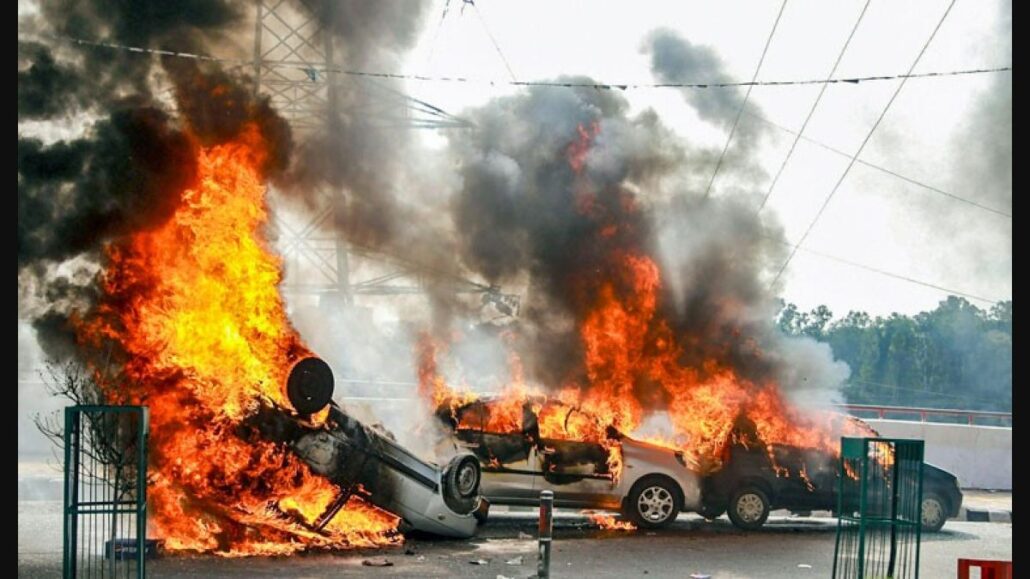
On Thursday, clashes erupted between Muslim locals and Uttarakhand Police after Mariyam Mosque, along with its adjoining Madarsa, was demolished in Bhanbhoolpura area in Haldwani, Uttarakhand, in an ‘encroachment drive’.
A large number of angry residents, including women, took to the streets as the two religious structures were being bulldozed.
The protesters broke down barricades, argued with the police personnel, and hurled stones at everyone involved in the demolition. The locals also set vehicles and the local police station on fire.
In the chaos, five Muslims were killed, and over 250 persons, including 12 policemen, were injured.
To maintain peace, four companies of paramilitary forces were deployed. Additionally, the entire state of Uttarakhand was put on high alert with a shoot-at-sight order against rioters.
“Four companies of paramilitary personnel have been sent to the violence-hit area of Haldwani. Two companies of PAC from Udham Singh Nagar have already reached Haldwani,” Inspector General Nilesh Anand Bharne, the spokesperson for Police Headquarters, is reported to have said, according to a report published in Livemint.
Nainital District Magistrate Vandana Singh assured that strict action will be taken against the identified ‘anarchic elements’. She refrained from turning the incident into a communal issue, as no particular community was involved in retaliation.
“The primary goal of the authorities is to establish peace in the area. Paramilitary forces, along with other arrangements, are being deployed to prevent property damage and avoid any casualties,” the DM added.
The Nainital District Administration has ordered a complete blockade of the Internet and a closure of schools and colleges until further notice.
According to a report published in PTI, officials claimed that most of the people hospitalized were police personnel and municipal workers involved in the demolition of the Mosque and the Madrasa.
“The incident that took place today in Haldwani’s Bhanbhoolpura area is unfortunate. All signs point towards it being an organized conspiracy,” Uttarakhand minister Ganesh Joshi said, speaking on the violence in Malik ka Bagicha.
Senior Superintendent of Police Prahlad Meena maintained that the Mosque and the Madrasa were built on illegally encroached government land.
However, according to a report published by BBC, the Muslims of the area who prayed in the Mosque claimed that they have been targeted unfairly.
Zafar Siddiqui, a resident of Bhanbhoolpura, told the Indian Express that the Mosque was built by one Abdul Malik who purchased the piece of land from someone who got it on lease.
In the same report, Shakeel Ahmad, a local councilor, added: “when the administration came to demolish the structures we asked them to stop until the next court hearing. But they did not listen. If they had waited for the final decision of the court, there would have been no resistance from us.”
In the same report published by BBC, the Muslim groups alleged that under the Hindu nationalist government of Narendra Modi, they are unfairly targeted and accused the government of religious polarization ahead of the national elections.
Demolition of Mosques, however, has become a ‘banal occurrence’ in India, where ‘illegal encroachment’ is cited as the main reason. The demolitions started as early as 1992 when the Babri Masjid was attacked by a mob of Hindu nationalists, claiming the ancient mosque was constructed on illegally encroached holy land, belonging to Hindus.
Days before the Uttarakhand incident, the Delhi Development Authority (DDA) bulldozed yet another centuries-old Mosque, the 600 years old Akhoondji Mosque and its adjoining Madrasa. Its Madrasa was home to 25 students, mostly orphans. The DDA alleged illegal encroachment as the reason for the demolition as well.
Anand Patwardhan, the man behind the 1992 documentary “Raam Ke Naam,” told The Art Newspaper that “the demolition of Babri Masjid was illegal and immoral.”
He refers to the demolition as an attempt to reimagine India. “Nobody is crying about the loss of a building structure. It is the loss of our secular ethos,” he adds.
Sarah Ather, an independent architect, in an Al Jazeera article writes, “the claim of illegality rests on a far-right narrative according to which most of the Indian mosques were actually temples at one point in time and were forcefully converted into mosques by Muslim rulers. Even though most historians today deny these claims because there is little material evidence to support them, they have enormous popular support.”
Earlier, Bhanbhoolpura area of Haldwani had made headlines in December 2022 after the court ordered the removal of encroachments of 29 acres of railway land. The residents protested then and were eventually granted relief by the Supreme Court.




